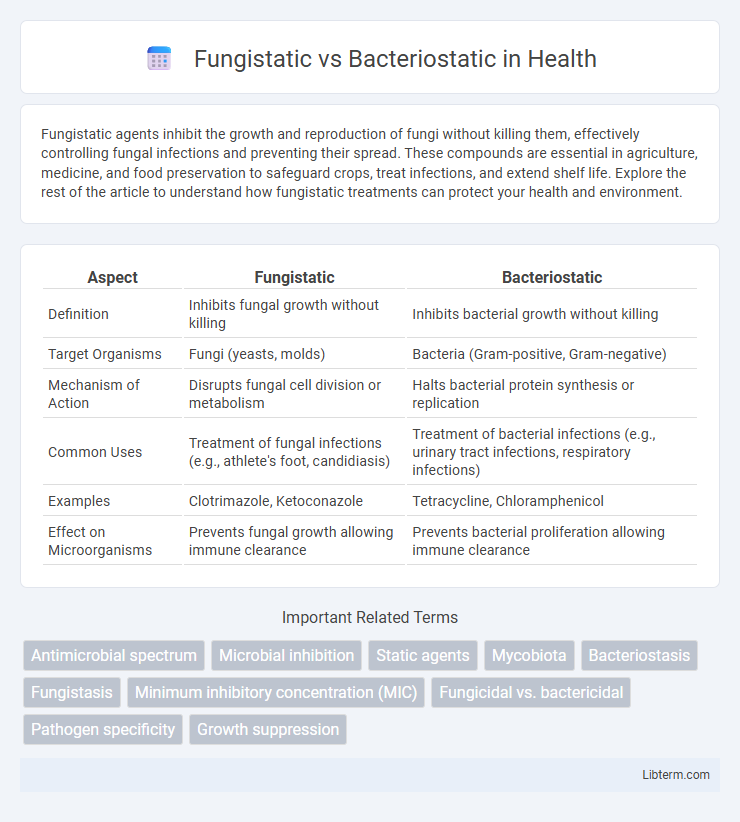Fungistatic agents inhibit the growth and reproduction of fungi without killing them, effectively controlling fungal infections and preventing their spread. These compounds are essential in agriculture, medicine, and food preservation to safeguard crops, treat infections, and extend shelf life. Explore the rest of the article to understand how fungistatic treatments can protect your health and environment.
Table of Comparison
| Aspect | Fungistatic | Bacteriostatic |
|---|---|---|
| Definition | Inhibits fungal growth without killing | Inhibits bacterial growth without killing |
| Target Organisms | Fungi (yeasts, molds) | Bacteria (Gram-positive, Gram-negative) |
| Mechanism of Action | Disrupts fungal cell division or metabolism | Halts bacterial protein synthesis or replication |
| Common Uses | Treatment of fungal infections (e.g., athlete's foot, candidiasis) | Treatment of bacterial infections (e.g., urinary tract infections, respiratory infections) |
| Examples | Clotrimazole, Ketoconazole | Tetracycline, Chloramphenicol |
| Effect on Microorganisms | Prevents fungal growth allowing immune clearance | Prevents bacterial proliferation allowing immune clearance |
Introduction to Antimicrobial Agents
Fungistatic agents inhibit the growth and reproduction of fungi without killing them, whereas bacteriostatic agents suppress bacterial growth, allowing the immune system to eliminate the pathogens. Both types of antimicrobial agents target specific cellular processes, such as protein synthesis or cell wall formation, to control microbial proliferation. Understanding the differences in their mechanisms is crucial for selecting appropriate treatments in fungal versus bacterial infections.
Definition of Fungistatic and Bacteriostatic
Fungistatic agents inhibit the growth and reproduction of fungi without killing them outright, allowing the immune system to eliminate the remaining fungal cells. Bacteriostatic substances similarly inhibit bacterial growth and replication, preventing proliferation while relying on host defenses for bacterial clearance. Both types of agents are critical in managing infections by controlling pathogen populations rather than eradicating them immediately.
Mechanisms of Action: Fungistatic vs Bacteriostatic
Fungistatic agents inhibit the growth and reproduction of fungi by targeting the synthesis of ergosterol, a key component of fungal cell membranes, or by disrupting essential enzymatic processes unique to fungi. Bacteriostatic agents impede bacterial proliferation primarily by interfering with protein synthesis, nucleic acid replication, or metabolic pathways critical to bacterial survival, such as folate synthesis. These distinct mechanisms reflect the specific cellular structures and biochemical pathways differences between fungi and bacteria, resulting in selective inhibition of their growth without immediate cell death.
Key Differences Between Fungistatic and Bacteriostatic Agents
Fungistatic agents inhibit the growth and reproduction of fungi without killing them, whereas bacteriostatic agents suppress bacterial proliferation without causing cell death. The key difference lies in their target organisms: fungistatics act specifically on fungal cell processes such as ergosterol synthesis, while bacteriostatics interfere with bacterial protein synthesis or metabolism. Understanding these distinctions informs the selection of appropriate antimicrobial therapies based on infection type and microbial susceptibility.
Clinical Applications and Therapeutic Uses
Fungistatic agents inhibit fungal growth by targeting cell membrane synthesis, commonly used in treating superficial and systemic mycoses such as candidiasis and dermatophytosis. Bacteriostatic drugs halt bacterial proliferation by interfering with protein synthesis or metabolic pathways, essential in managing infections like urinary tract infections and respiratory tract infections while minimizing bacterial resistance development. Both classes of agents are crucial in clinical settings for controlling pathogen load and allowing the host immune system to clear the infection effectively.
Common Examples of Fungistatic Agents
Common fungistatic agents include azoles such as fluconazole, itraconazole, and ketoconazole, which inhibit fungal cell membrane synthesis by targeting ergosterol production. Other examples are allylamines like terbinafine, which block squalene epoxidase, disrupting fungal cell wall formation. These agents prevent fungal growth by halting replication without directly killing the organism, distinguishing them from fungicidal compounds.
Common Examples of Bacteriostatic Agents
Common examples of bacteriostatic agents include tetracyclines, sulfonamides, macrolides, and chloramphenicol, which inhibit bacterial growth by interfering with protein synthesis or metabolic pathways. These agents do not kill bacteria outright but prevent replication, allowing the immune system to eliminate the infection. In contrast, fungistatic agents primarily inhibit fungal growth without killing fungal cells, emphasizing the distinction in target organisms between bacteriostatic and fungistatic treatments.
Factors Affecting Efficacy of Static Agents
The efficacy of fungistatic and bacteriostatic agents depends on factors such as concentration, environmental pH, temperature, and microbial growth phase. Higher concentrations usually enhance inhibitory activity, while suboptimal pH and temperature can reduce agent potency. The metabolic state of microbes, including whether cells are actively dividing or dormant, significantly influences the effectiveness of static antimicrobial compounds.
Resistance and Limitations of Fungistatic and Bacteriostatic Drugs
Fungistatic drugs inhibit fungal growth without killing the organisms, often leading to prolonged treatment courses that increase the risk of resistance development due to persistent fungal cells. Bacteriostatic agents suppress bacterial cell proliferation but rely on the host immune system for eradication, which can be ineffective in immunocompromised patients and promote resistance when sub-therapeutic drug levels allow survival of resistant strains. Both classes face limitations including potential for incomplete pathogen clearance and the emergence of resistant populations, necessitating careful use in clinical settings to minimize resistance.
Conclusion: Choosing the Right Approach for Infection Control
Fungistatic agents inhibit fungal growth without killing the organisms, while bacteriostatic agents prevent bacterial replication, allowing the immune system to eliminate the infection. Selecting the appropriate approach depends on the type of pathogen involved and the patient's immune status, with fungistatic treatments favored for fungal infections and bacteriostatic drugs used for bacterial infections. Effective infection control relies on accurate diagnosis and targeted therapy to optimize outcomes and minimize drug resistance.
Fungistatic Infographic

 libterm.com
libterm.com